Shubi is also named as Zhi, including "Shu" (comb) and "Bi"(fine-toothed comb) and was one of eight hair-styles in ancient China. It has a history of more than 1,500 years since it became popular in Wei Jin and North-south dynasties.
Legends of Shubi
It was said that after the death of the Yan Emperor (a legendary emperor in the early days of Chinese history who is said to be the inventor of agriculture and herbal medication), Chi You raised troops for revenge. Like many other people, Hao Lian, a craftsman, was forced to fight. In the Zhulu War, Xuan Yuan Emperor defeated Chi You, while Hao Lian was captured and placed in prison and condemned to death. A warder, Huang Fu, learned that Hao Lian could make combs, and advised him to make a comb overnight as a way to escape death . It was presented to Luo Zu Queen.
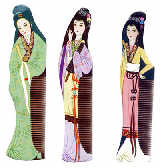
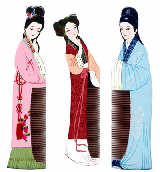
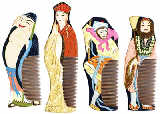
However, an amnesty order was too late, and Hao Lian was executed before it issued. Emperor Xuan Yuan felt very sad and appointed Huang Fu to lead craftsmen to make combs based on the model Hao Lian left behind. Since then, Hao Lian and Huang Fu have been esteemed as the founders of the comb trade.
The inventor of fined-toothed comb was Chen Qizi. During theSpring and Autumn Period(722 - 481 BC), an official, Chen Qizi, was put into prison after being found guilty . Living conditions in prison were so bad that lice reproduced on his head and the itching was intolerable. One day, after he had been heavily thrashed by jailors using bamboo planks, Chen Qizi found that the bamboo plank split into strips. He packed them up to clear away dirt and the lice cleared. This was the original fine-toothed comb.
It was also said that from then on on February 18 and September 28 of each lunar calendar year, a memorial ceremony for the comb and fined-toothed comb trade would be held for the founders, and practitioners could pray for flourishing future business.
Changzhou Shubi in history
Changzhou is Shubi's hometown. In Sui Dynasty (581-618 AD), the Jinghang Grand Canalcrossed through Changzhou city. At that time, all streets and alleys on both banks of the canal were jammed with comb workshops, and won titles of Mushu Street (Wooden Comb Street) and Biji Alley (Fine-toothed Comb Alley).
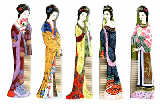

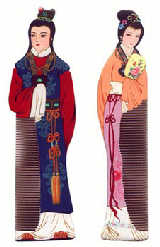
Standing on Wenheng Bridge with a right moon above and the Flower Street and Biji Alley below, one might enjoy the reflection of moonlight and lamps in the waves, and hear an ensemble of water, voices, steps , sculls and bamboo being split. The ancients named it the "Wenheng across the moon and comb shops lighting," and listed it as the first one of eight sights in the west suburbs of Changzhou.
In the region ofQianlongEmperor (1711-1799) during theQing Dynasty, almost every family in Changzhou made Shubi. In the Guangxu age, in July of every lunar calendar year,SuzhouWeaving Office would order 60 pieces of Changzhou boxwood combs and 60 pieces of first-class, fine-toothed combs with plum backs and eburnean teeth. Then, in October, together with sixdragonrobes and 600 royal flowers, they would be sent to theForbidden Cityand presented to the emperor. This was the origin of royal combs. It was said that Queen Mother Cixi especially cherished combs from Changzhou.
After the Republican Revolution of 1911, the demand for fined-toothed combs rapidly increased as more and more people began to cut their braids. At that time, a kind of small fined-toothed comb named " Liuhai Shubi" was very popular. Many people hung it from their pocket, and it became a fashion style.
Later, the Changzhou comb and fined-toothed comb were gradually introduced to the world. In 1915 they won the silver award in Panama International Exposition, and in 1926 won the gold award at the Philadelphia International Exposition in the United States.
Manufacture of Shubi
The manufacture of combs and fined-toothed combs is a complex and exquisite folk craft. Materials must be of the best quality, and the manufacturing process is also very complicated. The main materials for making combs are bamboo, wood and animal bones. The bamboo material is mainly selected from Yinshan grown, high-quality bamboo in South Jiangsu and West Zhejiang. Bamboo from these places is not only rigid and flexible but also durable. The wood material is mainly selected from such rare woods as rosewood, jujube wood, heath and boxwood. The comb and fined-toothed combs are made of boxwood and have fine wood character and clear grain, and also have functions of relieving headaches and itching, so they are particularly rare and welcomed. From preparing materials to the end product, a piece of wood comb needs 28 processes, and a single piece of fine-toothed comb needs 72 and a half processes. The delicate processes such as carving, drawing, scalding, engraving and grinding can only be finished by traditional manufacturing methods.
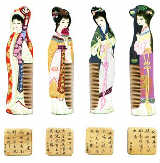
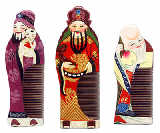
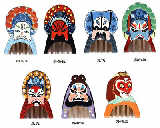

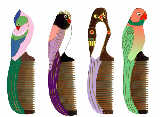

Special Status
Since ancient Chinese times, Chinese people have used combs and fine-toothed combs to maintain their health since doctors believed combing ones hair each day is an important need in traditional medicine.
According to " Qi Ju Zhu," every morning Empress Dowager Cixi in the Qing Dynasty spent a long time combing her hair, which helped it stay beautiful even in her 60s.
Combs and fine-toothed combs are also of high artistic value. Women often insert fine combs or fine-toothed combs in the hair buns.
Moreover, combs and fine-toothed combs are special in folk customs.
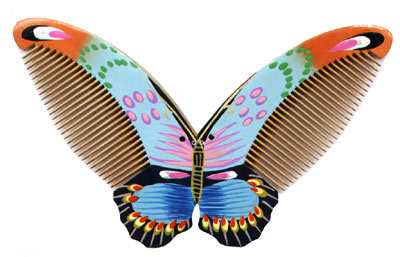
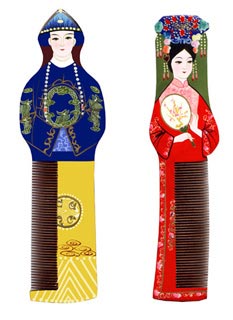
First, the business of such combs and comb-making and selling enjoys a kind of extremely special right in ancient and modern Chinese industry.
Second, combs are a symbol of a happy life, and are an essential dowry in ancient China and some countries in the north part of modern China.
However, combs in some nations are a kind of taboo. For example, for Tibetans, a comb must be hidden in a private place. People who wear combs on their hair are considered impolite.
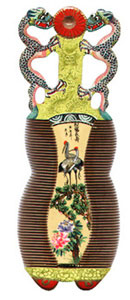
Changzhou Shubi enjoys good reputation
In Changzhou, there are nearly 1,000 special technicians in the comb and fined-toothed comb manufacturing sector, and more than 10,000 assistants. The output of fine-toothed combs is about 1,3 million pieces, while wood combs number nearly 2 million pieces every year. Each year there are several million combs exported throughout the world from Changzhou.
Changzhou combs -- used only by royals in the past -- are now are routinely used in daily life, and are also a national and traditional treasure.

